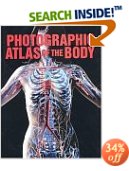Photographic Atlas of the Body

by Science Photo Library, Susan Greenfield
ISBN: 1552979733
Post Your Opinion | | A Review of: Photographic Atlas of the Body
by Olga SteinThe Photographic Atlas of the Body (Firefly, 288 pages) is marvelous
from the start-in fact from the start of its foreword, written by
Baroness Susan Greenfield. She begins with the following: "This
book truly spans the science/art divide. Indeed, it goes one better:
it shows how once can merge into the other. Science can actually
be art, and in turn, in the exquisite and ultimate mechanisms and
function of biology, there is an intrinsic beauty." Further
down, she writes of the section on the nervous system and the brain,
"I hope that you will be able to capture some of the excitement
that I had when I was first a student, wondering how such
quintessentially physical matter could generate subjective experiences
such as personality." Greenfield's words inadvertently hint
at a more profound confluence-that of science and religion. In The
Photographic Atlas of the Body, we find this subject crystalizing
around the most important of junctures-human biology, human life
itself. The 250 colour images of this book were scanned with the
most advanced imaging technology-Transmission Electron Microscopy,
Comptuted Tomography, Magnetic Resonance Imaging (these are just
three in a section at the front of the book which lists and explains
seventeen imaging techniques). The pictures are breathtaking for
the beauty and wonderousness of all that they reveal going on at
various levels of our physical life. A short but excellent introduction
to the book's first chapter, "Cells", gives us this vivid
passage:
"At the cellular level, the human body has been compared to a
vast city. But outside the pages of science fiction, no city is as
large, complex or efficiently organized as the human body. The
thousand or so different types of cells we possess work in superb
harmony to regulate all the processes essential for life-food
processing, production and storage; repair, transport and waste
disposal; surveillance and defence; communication and administration."
The city analogy serves perfectly to introduce the first chapter
and all those that follow - "Tissues", "Systems",
"Brain and the Senses". And while the first chapter is
entirely given over to cells, the cellular perspective is retained
in every other chapter in the book. Thus, we're shown the structural
appearance of blood vessels in the human neck, for example, while
on the next page an image taken by a Transmission Electron Microscope
zooms in on the blood cells inside a blood vessel in the spinal
cord. Or we're given a cross section of the spinal cord with its
regions of grey matter (nerve cells) and white matter (tracts of
nerve fibres), but in pages that follow, images taken with a Light
Micrograph offer closeups of the dentritic nerve cells of the spinal
cord, the essential transmitters of signals between the brain and
the rest of the body. My favorite images are of cells-a macrophage
white blood cell engulfing bacteria, pillar-like chochlea cells
which transform soundwaves into auditory signals, sperm and egg
cells, and mitotic cell division. But just about everything shown
in the book is fascinating, and the text accompanying each picture
is well written, clear and concise.
Baroness Greenfield closes her foreword with a thought-provoking
quote: "Someone once said that science is all about seeing
what everyone else can see, but thinking what no-one else has
thought'." I'd like to put it differently and say that science
is ultimately not about what one sees but what one is able to
imagine. Imagine the destination and you will find the way there.
With this book, we travel to that miraculous universe that is the
human body.
|